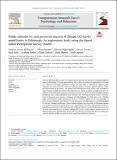Files in this item
Public attitudes to, and perceived impacts of 20mph (32 km/h) speed limits in Edinburgh : an exploratory study using the Speed Limits Perceptions Survey (SLiPS)
Item metadata
| dc.contributor.author | Williams, Andrew James | |
| dc.contributor.author | Manner, Jillian | |
| dc.contributor.author | Nightingale, Glenna | |
| dc.contributor.author | Turner, Kieran | |
| dc.contributor.author | Kelly, Paul | |
| dc.contributor.author | Baker, Graham | |
| dc.contributor.author | Cleland, Claire | |
| dc.contributor.author | Hunter, Ruth | |
| dc.contributor.author | Jepson, Ruth | |
| dc.date.accessioned | 2021-12-08T11:30:12Z | |
| dc.date.available | 2021-12-08T11:30:12Z | |
| dc.date.issued | 2022-01-01 | |
| dc.identifier | 276988087 | |
| dc.identifier | d4895dff-9ef3-41e6-855a-ca0a00d9f00e | |
| dc.identifier | 85120472166 | |
| dc.identifier | 000779518800008 | |
| dc.identifier.citation | Williams , A J , Manner , J , Nightingale , G , Turner , K , Kelly , P , Baker , G , Cleland , C , Hunter , R & Jepson , R 2022 , ' Public attitudes to, and perceived impacts of 20mph (32 km/h) speed limits in Edinburgh : an exploratory study using the Speed Limits Perceptions Survey (SLiPS) ' , Transportation Research Part F: Traffic Psychology and Behaviour , vol. 84 , pp. 99-113 . https://doi.org/10.1016/j.trf.2021.11.022 | en |
| dc.identifier.issn | 1369-8478 | |
| dc.identifier.other | ORCID: /0000-0002-2175-8836/work/104619449 | |
| dc.identifier.uri | https://hdl.handle.net/10023/24487 | |
| dc.description | The ‘Is 20 plenty for health?’ study is funded by a National Institute for Health Research (NIHR) Public Health Research (PHR) grant 15/82/12. | en |
| dc.description.abstract | Between 2016 and 2018 a policy was implemented to increase the proportion of 20mph (32km/h) streets in Edinburgh, UK from approximately 50% to 80%, providing the opportunity to evaluate how behaviour and public perceptions change over time. This is important as negative public responses have been reported to limit the implementation of transport policies and may reduce the effectiveness of the policy. The Speed Limits Perception Survey (SLiPS) was developed to assess changes in public perceptions from baseline to 6 and 12 months post-implementation. We collected 3,485 individual responses to the survey, 64.6% (n = 2,253) of which included complete perceptions data. Using exploratory factor analysis, the following perception factors were identified: i) Detraction and resistance, ii) Support, iii) Rule following, iv) Child safety, and v) Walking safety. Following the 20mph implementation at 6–12 months: Support (ii) and Rule following (iii) had increased; Detraction and resistance (i) had decreased; and Child safety (iv) and Walking safety (v) had not changed significantly. These findings indicate that the public in Edinburgh became more positive towards the policy once it was implemented. However, more extensive policy or ongoing communication of the safety benefits of 20mph limits are needed to increase perceptions of safety that might lead to increased walking and cycling. Future research should aim to understand how those implementing speed limit interventions can positively influence public perceptions and how public perceptions about speed limits influence behaviour. | |
| dc.format.extent | 15 | |
| dc.format.extent | 5226905 | |
| dc.language.iso | eng | |
| dc.relation.ispartof | Transportation Research Part F: Traffic Psychology and Behaviour | en |
| dc.subject | Policy | en |
| dc.subject | Transport | en |
| dc.subject | 20mph(32km/h) | en |
| dc.subject | Public perceptions | en |
| dc.subject | Walking | en |
| dc.subject | Cycling | en |
| dc.subject | RA Public aspects of medicine | en |
| dc.subject | E-DAS | en |
| dc.subject | MCC | en |
| dc.subject.lcc | RA | en |
| dc.title | Public attitudes to, and perceived impacts of 20mph (32 km/h) speed limits in Edinburgh : an exploratory study using the Speed Limits Perceptions Survey (SLiPS) | en |
| dc.type | Journal article | en |
| dc.contributor.institution | University of St Andrews. Population and Behavioural Science Division | en |
| dc.contributor.institution | University of St Andrews. School of Medicine | en |
| dc.identifier.doi | 10.1016/j.trf.2021.11.022 | |
| dc.description.status | Peer reviewed | en |
| dc.identifier.url | https://www.sciencedirect.com/science/article/pii/S1369847821002722?via%3Dihub#s0095 | en |
This item appears in the following Collection(s)
Items in the St Andrews Research Repository are protected by copyright, with all rights reserved, unless otherwise indicated.

